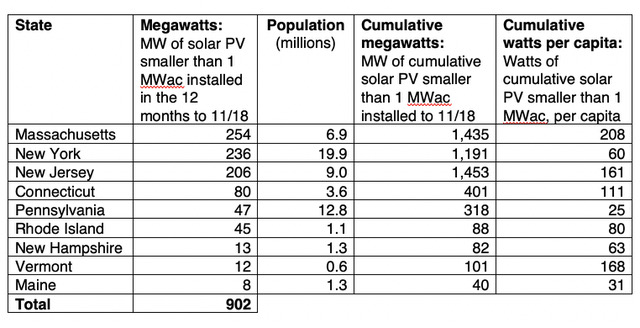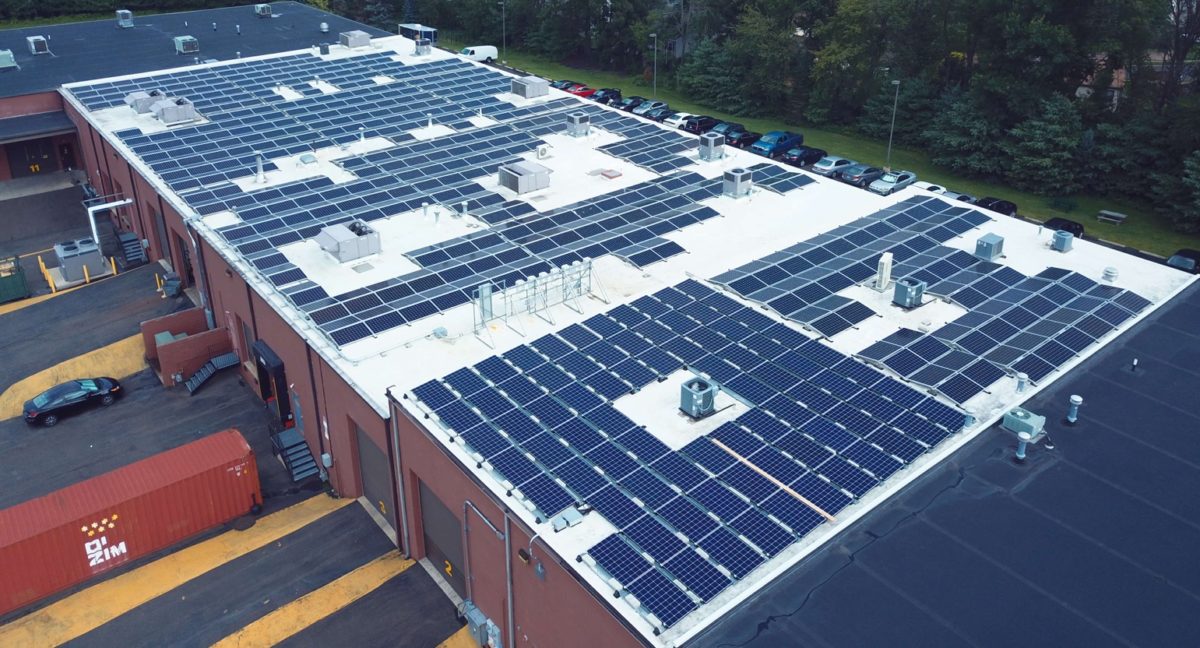Solar installation crews in the Northeast put up 902 MW of small-scale (under 1 MW) solar PV systems in the twelve months to November 2018.
Massachusetts, New York and New Jersey together added nearly 700 MW; Massachusetts also leads the solar-per-capita leaderboard. Vermont’s second-place per-capita standing is now at risk from a slowing pace of distributed installations, as New Jersey advanced in third place, reflecting its goal of 50% renewables by 2030; Connecticut ranks fourth.
If Northeastern installers maintained a 900 MW distributed solar pace in 2019, they would add 23% of the 3.9 GW of distributed generation projected to come online nationwide—according to the Energy Information Administration (EIA)—punching above the region’s 17% weight in the U.S. population.
Here are the small-scale installation data for nine Northeastern states, as reported in EIA’s Form EIA-861M reports:

Actual distributed totals may be higher, because solar installations connected to the distribution grid that are larger than 1 MW are not counted in the EIA data above.
Policy goals
Policy experts in the region offered their goals for advancing distributed solar in the coming year:
- New York: “We are thrilled by Governor Cuomo’s commitment to 6 GW of distributed solar by 2025,” said Sean Garren with Vote Solar. “We’re working with a broad coalition of clean energy and environmental advocates to ratify that commitment into law.” (Here’s our story on Governor Cuomo’s call for a “globally unprecedented ramp-up of renewable energy.”)
- Maine: “Our primary focus will be on passing a comprehensive piece of legislation, such as the forthcoming bill sponsored by Republican Senate Minority Leader, Dana Dow, to [make] it easier for residents, businesses, and towns to build new solar,” said Dylan Voorhees with the Natural Resource Council of Maine. He said the organization is hopeful for solar progress in Maine, given Governor Janet Mills’s pro-renewables stance.
- Massachusetts: The national solar group SEIA is “focused on ensuring the Massachusetts SMART program rolls out smoothly and any implementation issues during the regulatory review are resolved,” said David Gahl with the organization. Sean Garren with Vote Solar said Massachusetts must invest “in a modern, two-way electric grid,” raising caps on net metering, and serving low-income and environmental justice communities with clean energy. Meanwhile the solar group SEBANE “tracks key legislation and regulatory policy as it is proposed, and advocates around issues such as incentive programs, interconnection challenges and net metering,” said Mark Sylvia, the organization’s president.
- New Jersey: “With New Jersey’s passage of the Clean Energy Act in 2018, Vote Solar is now advocating for strong financial incentives to increase solar access in low-income and disadvantaged communities,” said Pari Kasotia with the organization.
Snapshot stories
Here are “snapshot stories” provided by solar installation firms, presenting projects from the past year:

Image: Exact Solar

Image: Image: Ron Tooker, Son Energy Systems

Image: Celentano Energy Services

Image: Adam Stein, Solar States
This content is protected by copyright and may not be reused. If you want to cooperate with us and would like to reuse some of our content, please contact: editors@pv-magazine.com.








By submitting this form you agree to pv magazine using your data for the purposes of publishing your comment.
Your personal data will only be disclosed or otherwise transmitted to third parties for the purposes of spam filtering or if this is necessary for technical maintenance of the website. Any other transfer to third parties will not take place unless this is justified on the basis of applicable data protection regulations or if pv magazine is legally obliged to do so.
You may revoke this consent at any time with effect for the future, in which case your personal data will be deleted immediately. Otherwise, your data will be deleted if pv magazine has processed your request or the purpose of data storage is fulfilled.
Further information on data privacy can be found in our Data Protection Policy.